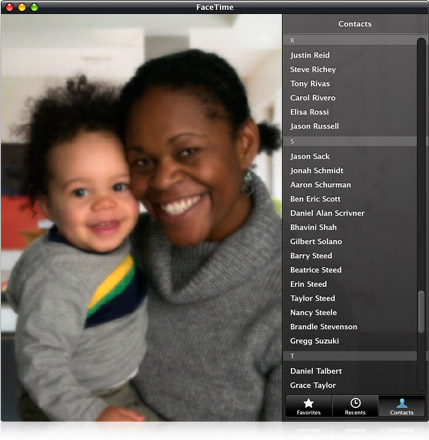 Regardless of the security issues FaceTime beta has had in the past (and fixed), we worked around it long enough to give it a try. Since there’s pretty high regard for those we work with, the threat of a stolen Apple ID didn’t get in the way of testing out one of the many hyped features of this year’s Back to Mac event.
Regardless of the security issues FaceTime beta has had in the past (and fixed), we worked around it long enough to give it a try. Since there’s pretty high regard for those we work with, the threat of a stolen Apple ID didn’t get in the way of testing out one of the many hyped features of this year’s Back to Mac event.
After an easy install, there wasn’t anything left to do other than connect with someone – something you can’t do directly in FaceTime. Your contacts are directly imported from your Mac’s Address Book, so if you don’t use it, you’re left with no one to chat with. It’s a pretty easy fix, obviously enough, since all you need to do is add e-mail addresses into the application. These then become your available contacts for FaceTime.
I can see this being an issue in two circumstances: first, if you are completely reliant on your Mac’s Address Book for all of your correspondence, you can potentially have hundreds of contacts when you open FaceTime – the only way to designate the ones you’d like to video chat with would be to list them under “Favorites” in your Address Book. Still, it’s mildly annoying.

Second, if you use a substitute to the Address Book, you either have to rely on someone more industrious than yourself to contact you, or you have to repeat your work and add your contacts into it. Entourage, OpenOffice, and products like them are extremely common, so be prepared for that hang up. Hopefully, Apple acknowledges this and will find this kink equally obnoxious, and allow users to enter contacts directly into FaceTime.
Otherwise, no serious complaints. You can rotate to a landscape view (which could be convenient), the image is clear, and there’s no noticeable lag. There isn’t really any room for personalization, but remember, this isn’t the finished product.
Editors' Recommendations
- Apple’s FaceTime may soon give you gesture control superpowers
- How to create a Memoji on a Mac
- Let’s face it: The upcoming iMac Pro needs a notch
- Mac usage is growing rapidly, but iOS still outpaces it by about 10 times
- Mac OS X is 20 years old today. Here’s why it was so revolutionary


